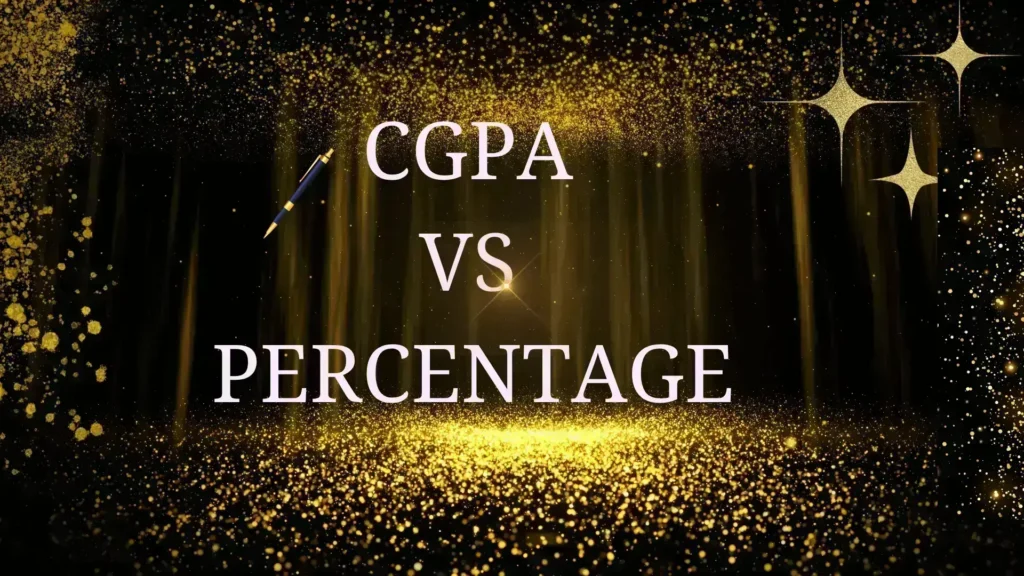CGPA vs Percentage: Which One Makes Sense for Students?
You may have heard things like CGPA and percentage in your educational institutions. You should be familiar with both of these terms. Back when I was in 10th grade, I got marked through the old school percentage system. My cousin went through CGPA during his board exams. And let me tell you, our experiences weren’t the same at all.

So here in this article, I’m just breaking it all down. No complicated terms. No boring technical stuff. Just straight-up, real talk to help you figure out what works for you.
What Is CGPA or Percentage?
CGPA (Cumulative Grade Point Average) is your overall grade. With the help of CGPA, you can check your performance in all subjects. Think of it like a summary of your performance.
A percentage is much simpler. No decoding, no conversion. Just raw numbers. This allows you to check your marks or performance out of 100.
And yeah, you can switch between the two if needed. Depending on where you apply, whether it’s a college, a job, or somewhere abroad, they might ask for either one. So knowing how to flip between them comes in handy.
Easy Tools to Use
So… Which One’s More “You”?
It depends on how your brain works. If you’re the kind of person who looks at overall growth, wants to chill a bit, and doesn’t want to cry over one bad exam, then CGPA might feel better.
But if you’re someone who loves clarity, wants the cold, hard truth of every subject, and likes tracking each little detail, percentage is your jam. No right or wrong here. Just whatever clicks with your style.
Comparison Table
| Factor | CGPA | Percentage |
| Scale | 1–10 | Out of 100 |
| Stress Level | Lower | Higher |
| Transparency | Low (hides exact marks) | High (shows exact marks) |
| Usage | Common in colleges | Common in schools, jobs |
Let’s Talk Pros and Cons (Because Nothing’s Perfect)
Here’s a quick breakdown of what’s great and not so great about both systems.
✅Why CGPA Can Be a Win
- Covers All Subjects Together – It gives a smooth average of how you did overall.
- Takes the Pressure Off – One bad test doesn’t ruin your whole year.
❌ But Also… Not So Great
- Hides Your Actual Marks – You don’t know how much you scored.
- You can feel puzzled – You may have good marks in 1 subject, but weak in another subject, and end up taking average grades.
✅ Why Percentage Feels More Honest
- Tells You Everything – You see your actual marks, no hiding.
- Super Easy to Compare – You know exactly which subjects you did well in (and which ones were a disaster).
❌ But It Can Suck Sometimes
- Way More Stressful – Every single exam counts, and a bad day messes things up.
- No Bigger Picture – It doesn’t show whether you’ve been improving overall or not.
Importance from various aspects
Let’s talk situations.
In Schools:
In schools, some boards prefer CGPA because it gives a perfect summary of overall performance, while others stick with percentage since it shows each subject clearly.
At College Level:
The CGPA system is preferred in colleges where there are separate marks for quizzes, presentations, and performance.
But in old school? They still go with percentages, especially if everything depends on just the final exams.
In Jobs:
Some companies prefer CGPA since it shows steady performance across semesters. Others, especially in tech fields, ask for percentage, as they care more about your marks in specific core subjects.
For Further Studies:
Planning for a Master’s or applying abroad? You’ll probably need both. Yep. A lot of universities abroad will ask you to provide both formats, or at least convert one into the other. You should understand the whole criteria instead of applying immediately.
What Are Students Saying?
Some love CGPA because it’s less stressful and feels more forgiving. Like, if you’re weak in one subject, it doesn’t mess everything up. Others are all for percentages. It’s honest, it’s detailed, and you always know where you stand, no smoke and mirrors.
Final Thoughts
At the end of the day, CGPA vs percentage isn’t about which one’s better. It’s all about what you consider the best. If you prefer to see your overall growth and don’t want to obsess over every single mark, consider using CGPA. If you want total transparency and care about every little detail, a percentage is probably your best bet. But either way, remember that numbers don’t define your worth.
